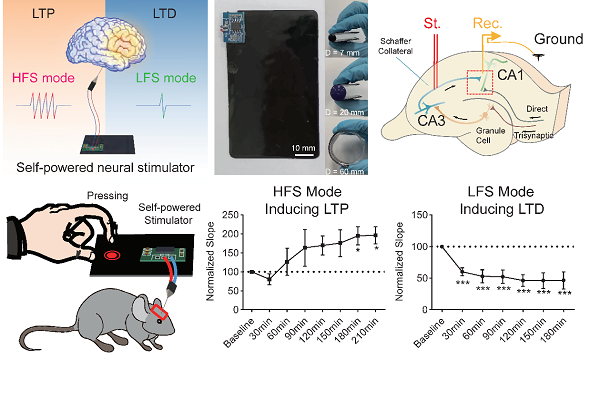Self-powered Flexible Neurostimulator Achieves Bidirectional Modulation of Neural Plasticity
Date:26-04-2021 | 【Print】 【close】
Recently, Dr. ZHAN Yang team of the Brain Intelligence Center and Dr. LI Guanglin team of the Neural Engineering Center at the Shenzhen Institutes of Advanced Technology (SIAT) of the Chinese Academy of Sciences, collaborated with the team of the University of Electronic Science and Technology of China, developed a self-powered flexible wearable neural stimulator to achieve bidirectional modulation of neural plasticity. Related results were published on Nano Energy (impact factor 16.602) titled ”Bidirectional modulation of neural plasticity by self-powered neural stimulation” .
Modulating neural plasticity is considered to be an effective means to treat diseases such as Alzheimer's disease, drug addiction and stroke. At present, common commercial neural stimulators usually require batteries or sockets to maintain the power supply. The bulky system framework and inflexible component design limit the comprehensive application of the equipment. In order to tackle this technical bottleneck, the research teams collaborated to design a self-powered flexible wearable neural stimulator, which can induce the formation of long-term potentiation or depression through generating high-frequency and low-frequency pulses in two modes and thus achieving the bidirectional adjustment of neural plasticity. The self-powered flexible wearable neural stimulator integrates an elastic self-powered nanogenerator, a signal modulation unit and a nerve stimulation electrode. The stimulator' s small size, lightweight, elasticity and portability allow it to convert the mechanical energy generated during exercise into a nerve stimulation signal and modulate the synaptic plasticity.
The self-powered flexible wearable nerve stimulator has been demonstrated in awake animal models. The researchers connected the device to the mouse brain, and the signal modulation module transmitted the collected energy into a dual-mode stimulation signal, successfully inducing the formation of long-term potentiation and depression of the hippocampus without external energy supply. This work overcomes the shortcomings of traditional commercial electric stimulators, such as the bulky size of the equipment and the potential hidden dangers of the power supply. The neural stimulator would provide new ideas for the treatment of neurological diseases based on synaptic plasticity and bidirectional brain-computer interaction.
Shenzhen Institute of Advanced Technology and the University of Electronic Science and Technology are the communication units. HAN Yechao, research assistant of SIAT and ZHAO Tianming, visiting student of SIAT and doctoral student of Northeastern University are co-first authors. Researcher Dr. LI Guanglin of SIAT, researcher Dr. ZHAN Yang and professor Dr. XUE Xinyu of University of Electronic Science and Technology of China are co-corresponding authors.
This project was funded by the National Key Research and Development Program, the National Natural Science Foundation of China, the Shenzhen-Hong Kong Institute of Brain Science, and the Sichuan Science and Technology Program.

Figure1. Self-powered flexible neurostimulator achieves bidirectional modulation of neural plasticity
Media Contact:
SUN Lujia
Email: lj.sun@siat.ac.cn
Download the attachment:
Bidirectional modulation of neural plasticity by self-powered neural stimulation